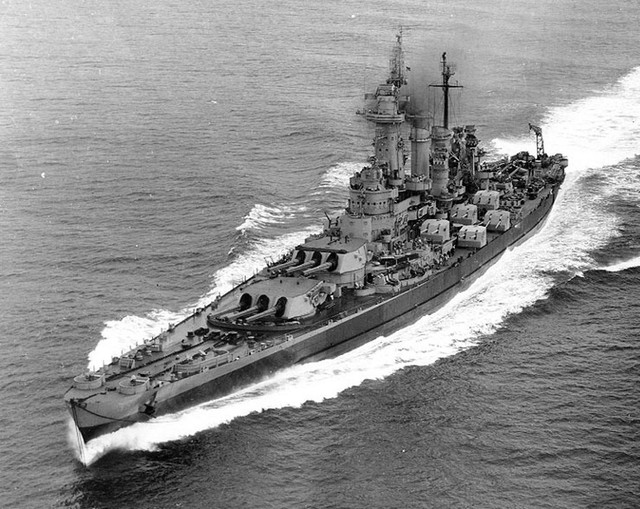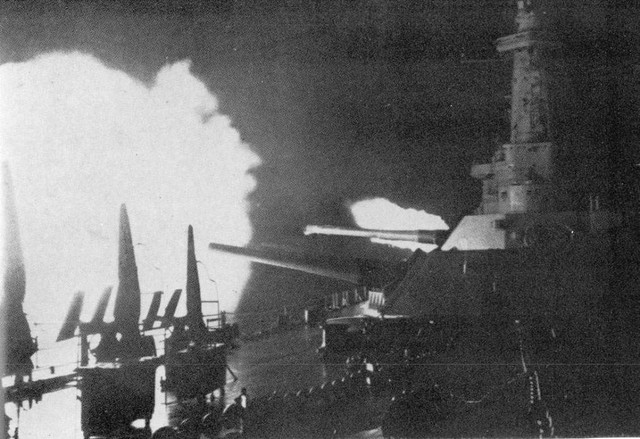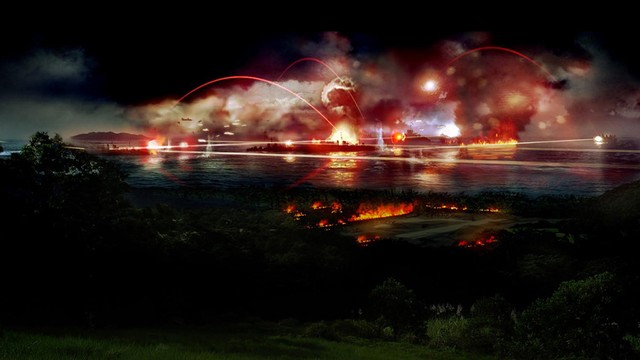It was not until the end of the war that the United States realized that it had suffered much heavier losses than Japan and had lost strategically at the time, unprecedented.
November 12, 1942 – The Battle of Guadalcanal begins to change the landscape of the Pacific
Operation Guadalcanal, code-named Operation Watchtower, took place from 7/8/1942 to 9/02/1943 on Guadalcanal Island and its surroundings in the Solomon Islands of the Pacific Front during the war. The dispute took place fiercely both on land, at sea and in the air; This campaign was the Allies’ first major attack on the Japanese Empire after a long defense. The highlight of this campaign was the Naval Battle of Guadalcanal – one of the fiercest battles of WWII – which took place from November 12, 1942 to November 15, 1942. The naval battle consisted of several air strikes and artillery battles between the battleships over the course of four days, most of which were near Guadalcanal and involved the Japanese attempt to land troops on the island. This battle was marked by the fact that the only two admirals in the US Navy were killed during the war.
It all started on August 8, 1942, when 11,000 Allied troops took control of Tulagi, neighboring islands, and a Japanese airfield under construction at Lunga Point was later called Henderson. To protect the airfield, the US Marines established a defensive perimeter around Lunga Point. The reinforcements were transported two months later, bringing the number of US troops at Lunga Point to 20,000. In response, the Japanese headquarters tasked the 17th Army, a corps-sized unit stationed in Rabaul under the command of Lieutenant-General Hyakutake Harukichi, to retake Guadalcanal. 17 army units began moving to Guadalcanal on August 19 to drive Allied forces off the island.
The Japanese army planned to attack another Guadalcanal in November 1942, but reinforcements were needed before the plan could be carried out. The military enlisted Yamamoto’s help in sending reinforcements to the island and assisting them in the attack on Allied forces entrenched at Henderson Airport. To support the reinforcement, Yamamoto assembled 11 large transport ships to transport 7,000 soldiers of the 38th Infantry Division with Rabaul ammunition, food and heavy equipment to Guadalcanal. He also sent warships from Truk to join the fleet on November 9, including two battleships. Battleships Hiei and Kirishima were armed with deadly high explosive shells which were used to bomb Henderson on the night of November 12 and November 13, in order to destroy the airport and the squadron of aircraft stationed there. Slow and large transport ships reach Guadalcanal safely the next day. The fleet will take command of the flagship Hiei, which Vice-Admiral Abe Hiroaki commands.

Abe Hiroaki’s fleet formed a formation 110 km north of Indispensable Strait and began marching towards Guadalcanal on November 12, with an expected arrival early the next morning on November 13. The slower convoy with 11 or 12 destroyers commanded by Tanaka Raizo began to enter New Georgia Sound from the Shortlands as scheduled to reach Guadalcanal on the night of November 13.
In addition to the two battleships, Abe’s fleet included the light cruiser Nagara and 11 destroyers divided into two groups. Destroyer Group 10 is commanded by Navy Major General Kimura Susumu, Destroyer Group No. 4 is commanded by Navy Major General Takama Tamotsu. The three destroyers Shigure, Shiratsuyu and Yugure served in the rearguard service in the Russell Islands as Abe’s fleet penetrated the waters around the north island of Savo off Guadalcanal.
American reconnaissance planes detected the approach of the Japanese fleet and signaled a warning signal to Allied commanders. After receiving this warning, Richmond K. urner rallied and separated all combatable ships from the convoy to protect the forces ashore at Guadalcanal against possible Japanese attacks and landings. This happened at the same time, ordered transports to withdraw from the area at sunset on November 12.
Admiral Daniel Callaghan was over a few days old and was appointed Commander-in-Chief, although Norman Scott was more experienced. Callaghan prepares to engage the Japanese Night Fleet in a fierce battle. Callaghan’s navy consisted of two heavy cruisers San Francisco and Portland, three light cruisers Helena, Juneau and Atlanta, and eight other destroyers. Admiral Callaghan commanded the San Francisco.
On reaching Guadalcanal, the Japanese fleet entered a strong and heavy rainstorm, due to Abe’s complicated training and confused orders, the Japanese fleet formation split into several groups. The US fleet was lined up around the Savo Sea with destroyers standing in front and behind the defenses and cruisers in the center. The distance between destroyers and cruisers was 730 m, between cruisers 640 m, and between destroyers 460 m. All five ships were fitted with new radar sensors and had a long range, but Callaghan decided not to let them stand in front of the defense line, and also chose not to choose which ship would be his flagship. Callaghan did not release the battle plans to the captains of his fleet.
At approximately 1:25 a.m. on 11/13 in dark conditions due to heavy rain and a waning moon, the Japanese fleet entered the Strait and entered Saverson in flight. Japanese at 1:24 am but had communication problems announcing the Japanese train at 1:24 am, but had communication problems informing Callaghan, due to the radio failure, also as a lack of discipline in Communication.
A few minutes later, the two forces saw each other almost simultaneously, but Abe Hiroaki and Daniel J. Callaghan hesitantly ordered their ships to attack immediately. Abe was almost surprised that the enemy fleet was too close to decide whether to order a temporary retreat so that the battleships had enough time to change damaged bullets (used for artillery) into anti-ship bullets, or continue to moving forward. He decided to continue, while Callaghan tried to strike the flank of the Japanese fleet but was confused by receiving only incomplete information, and because the formation of the Japanese fleet was divided into small groups, he therefore gave orders to move. fleet confused, and in general he wasted too much time before acting. The United States warship squadron began to disintegrate, contributing to Callaghan’s delay in ordering the fire, in order to identify and reorganize the formation. As the Japanese ships were entwined amid the American formation, captains on both sides eagerly awaited the order to fire.
 At 1:48 a.m., Akatsuki and Hiei turned on two detection beacons in Atlanta just 1.7 miles away (which was the direct range of large combat ships). Several ships on both sides began to shoot at each other sporadically. Realizing that his forces were surrounded by Japanese ships, Callaghan ordered “a strange train to open fire on starboard, even train on starboard”, but before the battle broke out the ships were not numbered and the formation of the ships was inherently chaotic. All of the remaining U.S. ships have yet to open fire, and others have had to switch targets to comply with Callaghan’s orders. The two forces were in a mixed position, firing their melee artillery at each other as chaosly as the naval battles of previous centuries. Navigator Monssen described the battle “as if there was a power outage in a bar with the lights out”. Meanwhile, Robert Leckie, a US Navy who witnessed the Battle of Guadalcanal, said: “The flares shot high, terribly and red. Huge flares tore through the night. In the orange light. .. The surface of the sea was like a polished stone of glass on which warships were dropped, motionless, causing the centers of the circles to spill out like falling stones. In the mud “.
At 1:48 a.m., Akatsuki and Hiei turned on two detection beacons in Atlanta just 1.7 miles away (which was the direct range of large combat ships). Several ships on both sides began to shoot at each other sporadically. Realizing that his forces were surrounded by Japanese ships, Callaghan ordered “a strange train to open fire on starboard, even train on starboard”, but before the battle broke out the ships were not numbered and the formation of the ships was inherently chaotic. All of the remaining U.S. ships have yet to open fire, and others have had to switch targets to comply with Callaghan’s orders. The two forces were in a mixed position, firing their melee artillery at each other as chaosly as the naval battles of previous centuries. Navigator Monssen described the battle “as if there was a power outage in a bar with the lights out”. Meanwhile, Robert Leckie, a US Navy who witnessed the Battle of Guadalcanal, said: “The flares shot high, terribly and red. Huge flares tore through the night. In the orange light. .. The surface of the sea was like a polished stone of glass on which warships were dropped, motionless, causing the centers of the circles to spill out like falling stones. In the mud “.
 After 40 minutes of hand-to-hand combat, the fleets on both sides began to gradually separate and cease fire at 2:26 a.m. after Abe and Captain Gilbert Hoover (Captain Helena and Commander-in-Chief of the Chinese fleet Ky have survived until then.) ordered a ceasefire. On Admiral Abe’s side, a battleship, a light cruiser and four destroyers were only slightly damaged and four other destroyers were relatively damaged. On the American side, only one light cruiser and one destroyer were able to resist. Although Abe may not have noticed it, the situation prevented his fleet from bombarding Henderson Airport and completely destroying the US fleet, creating a safe zone to disembark reinforcements and supplies. Whatever the reason, Abe ordered a ceasefire and pulled all warships out of the area, though Yukikaze and Teruzuki stayed to help Hiei.
After 40 minutes of hand-to-hand combat, the fleets on both sides began to gradually separate and cease fire at 2:26 a.m. after Abe and Captain Gilbert Hoover (Captain Helena and Commander-in-Chief of the Chinese fleet Ky have survived until then.) ordered a ceasefire. On Admiral Abe’s side, a battleship, a light cruiser and four destroyers were only slightly damaged and four other destroyers were relatively damaged. On the American side, only one light cruiser and one destroyer were able to resist. Although Abe may not have noticed it, the situation prevented his fleet from bombarding Henderson Airport and completely destroying the US fleet, creating a safe zone to disembark reinforcements and supplies. Whatever the reason, Abe ordered a ceasefire and pulled all warships out of the area, though Yukikaze and Teruzuki stayed to help Hiei.
At around 3 a.m. on November 13, Admiral Yamamoto postponed the convoy’s landing plan and all returned to Shortlands to await further orders. At dawn three paralyzed Japanese ships arrived, Hiei, Yudachi and Amatsukaze, and three other crippled American ships, the Portland, Atlanta and Aaron Ward, located off the island of Savo. The tugboat Bobolink circled the waters of New Georgia Sound throughout November 13 to assist US ships and survivors as well as to report shooting at all Japanese survivors floating in the water. Due to the confusion over the nature of the battle, the United States believed it had sunk at least seven Japanese ships. Moreover, the Japanese retreat made the United States even more convinced that it had won. It was not until the end of the war that the United States realized that it had suffered much heavier losses than Japan and had lost strategically at the time, unprecedented.
It was the last major naval battle for Japan to attempt to recapture Henderson Airport or to encircle the surrounding waters. The US Navy succeeded in resupplying its forces at Guadalcanal, including introducing two divisions at the end of December 1942. Failure to neutralize Henderson frustrated all Japanese attempts against US forces attacking Guadalcanal. The last Japanese rebellion came at the end of the Guadalcanal campaign on February 9, 1943 when Japan evacuated all forces from all the islands during Operation Ke. The victory of the Guadalcanal campaign helped the Allies consolidate elsewhere in the region and helped end World War II when Japan surrendered. US President Franklin Roosevelt said after seeing the outcome of the battle: “It seems that a turning point has been made in the war.”


